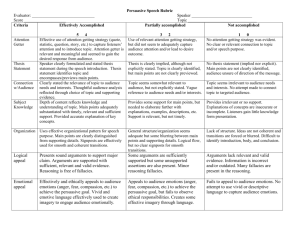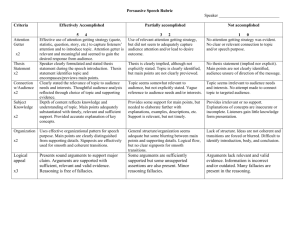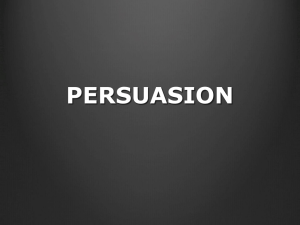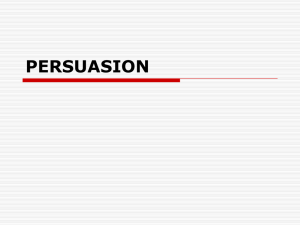peer-review-MODERNpersuasive-speech
advertisement
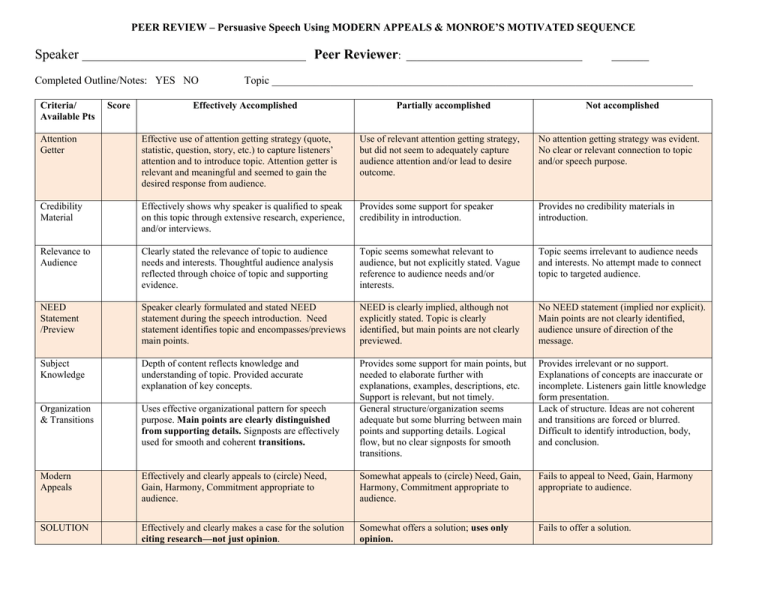
PEER REVIEW – Persuasive Speech Using MODERN APPEALS & MONROE’S MOTIVATED SEQUENCE Speaker __________________________________________ Peer Reviewer: Completed Outline/Notes: YES NO Criteria/ Available Pts Score _________________________________ _______ Topic _______________________________________________________________________________ Effectively Accomplished Partially accomplished Not accomplished Attention Getter Effective use of attention getting strategy (quote, statistic, question, story, etc.) to capture listeners’ attention and to introduce topic. Attention getter is relevant and meaningful and seemed to gain the desired response from audience. Use of relevant attention getting strategy, but did not seem to adequately capture audience attention and/or lead to desire outcome. No attention getting strategy was evident. No clear or relevant connection to topic and/or speech purpose. Credibility Material Effectively shows why speaker is qualified to speak on this topic through extensive research, experience, and/or interviews. Provides some support for speaker credibility in introduction. Provides no credibility materials in introduction. Relevance to Audience Clearly stated the relevance of topic to audience needs and interests. Thoughtful audience analysis reflected through choice of topic and supporting evidence. Topic seems somewhat relevant to audience, but not explicitly stated. Vague reference to audience needs and/or interests. Topic seems irrelevant to audience needs and interests. No attempt made to connect topic to targeted audience. NEED Statement /Preview Speaker clearly formulated and stated NEED statement during the speech introduction. Need statement identifies topic and encompasses/previews main points. NEED is clearly implied, although not explicitly stated. Topic is clearly identified, but main points are not clearly previewed. No NEED statement (implied nor explicit). Main points are not clearly identified, audience unsure of direction of the message. Subject Knowledge Depth of content reflects knowledge and understanding of topic. Provided accurate explanation of key concepts. Organization & Transitions Uses effective organizational pattern for speech purpose. Main points are clearly distinguished from supporting details. Signposts are effectively used for smooth and coherent transitions. Provides some support for main points, but needed to elaborate further with explanations, examples, descriptions, etc. Support is relevant, but not timely. General structure/organization seems adequate but some blurring between main points and supporting details. Logical flow, but no clear signposts for smooth transitions. Provides irrelevant or no support. Explanations of concepts are inaccurate or incomplete. Listeners gain little knowledge form presentation. Lack of structure. Ideas are not coherent and transitions are forced or blurred. Difficult to identify introduction, body, and conclusion. Modern Appeals Effectively and clearly appeals to (circle) Need, Gain, Harmony, Commitment appropriate to audience. Somewhat appeals to (circle) Need, Gain, Harmony, Commitment appropriate to audience. Fails to appeal to Need, Gain, Harmony appropriate to audience. SOLUTION Effectively and clearly makes a case for the solution citing research—not just opinion. Somewhat offers a solution; uses only opinion. Fails to offer a solution. ACTION Effectively states what audience is supposed to do with the information, makes a summary statement of key points from research, and provides a WOW statement that supports a call to action. Sources of information are clearly identified and properly cited. Establishes credibility and authority of sources presented. Balances a variety of perspectives and recognizes opposing views. 3 References Cited Somewhat provides an effective call to action in conclusion. Provides a weak, incomplete, or no call to action in conclusion. Most sources are clearly cited, but fails to effectively establish credibility and authority of sources presented. Seems fair, but fails to acknowledge opposing perspectives. 1-2 References Cited Fails to identify and cite sources. No attempt is made to establish credibility and authority of sources presented. One-sided argument, no other perspectives are considered. Some identifiable bias. Logical appeal Presents sound arguments to support major claim. Arguments are supported with sufficient, relevant and valid evidence. Reasoning is free of fallacies. Some arguments are sufficiently supported but some unsupported assertions are also present. Minor reasoning fallacies. Emotional appeal Effectively and ethically appeals to audience emotions (anger, fear, compassion, etc.) to achieve the persuasive goal. Vivid and emotive language effectively used to create imagery to engage audience emotionally. Appeals to audience emotions (anger, fear, compassion, etc.) to achieve the persuasive goal, but fails to observe ethical responsibilities. Creates some effective imagery through language. Arguments lack relevant and valid evidence. Information is incorrect and/or outdated. Many fallacies are present in the reasoning. Fails to appeal to audience emotions. No attempt to use vivid or descriptive language to capture audience emotions. Eye contact Consistently and effectively used eye contact to establish rapport with audience. Inconspicuous use of speaker notes and effective use of scanning to established an expanded zone of interaction. Conspicuous use of speaker notes. Seems disengaged from audience for noticeable periods of time. Reads speech from notes/manuscript. Avoids eye contact with audience. Only occasional and sporadic glances. Body language Expressive, dynamic, and natural use of gestures, posture and facial expressions to reinforce and enhance meaning. Body language reflects comfort interacting with audience. Stiff or unnatural use of nonverbal behaviors. Body language reflects some discomfort interacting with audience. Limited use of gestures to reinforce verbal message. Body language reflects a reluctance to interact with audience. Distracting movement and/or use of self-adaptive behaviors. Voice Natural variation of vocal characteristics (rate, pitch, volume, tone) in Standard English to heighten interest and match message appropriately. Limited variation of vocal characteristics. Use of rate, pitch, volume and tone seemed inconsistent at times. Monotone or inappropriate variation of vocal characteristics. Inconsistent with verbal message. Fluency Appropriate pronunciation, enunciation, and articulation. Lack of noticeable vocalized fillers. Few noticeable errors in pronunciation, enunciation and articulation. Minimal use of vocalized fillers. Excessive fluency errors interfered with message comprehension. Excessive use of vocalized fillers. SLIDES Five or more slides with visuals and little to no text—no bullets—effectively supporting presentation. 3-4 slides OR 5 slides with bullet points and lots of text. Incomplete or ineffectual slides. Ethical appeal Credibility Total Score _______________________
